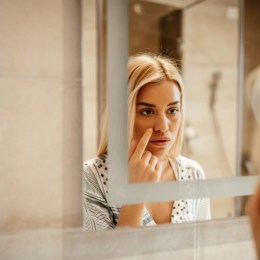It’s not just the postures and expressions we adopt when using our e-devices – eg. “Tech Neck” and “Phone Face” – that are accelerating the symptoms of ageing.
According to leading UK trend forecaster The Future Laboratory‘s Beauty Futures Report, a sinister new foe is emerging: High-Energy Visible (HEV) rays emitted by the screens that we all spend hours each day staring at.
Researchers have discovered that the blue light emitted by these screens could be more damaging to skin than UVA and UVB rays from the sun, and even penetrate skin deeply enough to affect DNA.
“We probably spend more time in front of a screen than under the sun now,” according to the report.
“Smartphones, laptops, TV… you can’t even get into a taxi now without being in front of a screen.
“Simply offering SPF in products won’t cut it any longer. Neither will scaremongering about the possible risks associated with spending hours texting.
“Consumers are looking for practical solutions to the digital ills that afflict them because they’re not going to give up their technology any time soon.
“New ingredients, such as marine algae, that shield the skin from HEV light in the same way that more traditional formulations fend off UVA and UVB rays are one of the ways forward.”
The report nominates French skincare brand Dr Sebagh (created by Dr Jean-Louis Sebagh, acknowledged as one of the premier cosmetic doctors in Europe; much sought-after by celebrities such as Cindy Crawford) as having formulated the first day cream to contain a unique melanin compound designed to protect against HEV rays.
Megan Manco, SkinCeuticals* skincare Scientific Director, explains more, and what we can do to protect our skin:
There are a multitude of things that are harmful to our skin, from UV rays to a bad diet but there are two predominant issues that have come to the fore this year – pollution and blue light from electronic devices.
So why are these issues trending now? Environmental skin ageing is a research topic currently garnering a great deal of attention in skincare.
Visible light, as opposed to blue light, is gaining more relevance as the effects of visible light on the skin are becoming more clearly elucidated.
We also now know that the sun (UVB, UVA rays) isn’t the only atmospheric factor impacting the quality of our skin.

Environmental impurities, like ground level ozone (O3) pollution, have also been shown to cause signs of premature ageing. Pollution levels have never been higher, and this is having a significant impact on our skin.
Pollution causes damage to the skin in various ways such as weakened antioxidant defences at the surface, increase in dehydration, increase in sebum production and more.
Skin damage due to ozone exposure is mainly mediated by its ability to induce oxidative stress. More specifically, exposure to ozone pollution (O3) has been shown (in vivo) to oxidise lipids, deplete skin’s natural antioxidant reservoir, activate inflammatory pathways, and cause collagen degradation.
There are therefore longterm effects from pollution on the skin. The compounded effect of ozone-induced oxidative stress leads to accelerated signs of skin ageing including appearance of fine lines and wrinkles, loss of radiance, skin laxity, as well as diffuse and localised pigmentation.
So what ingredients can help to protect against these damaging effects and how do they achieve this?
SkinCeuticals’ latest study (due for publication in the Journal of Investigative Dermatology) has shown that topical vitamin C formulations, such as SkinCeuticals’ C E Ferulic or Phloretin CF can have a highly protective effect, significantly reducing the oxidative damage caused by O3 exposure by:
- Reducing lipid peroxidation: shown by a reduction in HNE proteins, that are generated by free radical attack on fatty acids in skin exposed to ozone pollution
- Preventing inflammation: shown by a reduction in the NFkB pathway
- Preventing collagen loss: O3 exposure significantly decreases Type I and Type III collagen
A comprehensive skincare regimen is required to provide both protection and prevention from environmental aggressors. An SPF on its own is not enough as we now know that even the best broad spectrum sunscreen may only block up to 55% of damaging free radicals generated by UV exposure.
Broad spectrum sunscreens protect by reflecting and absorbing UVA/UVB rays from skin’s surface to protect against photoageing but do not provide complete protection from free radical damage. Efficient antioxidants neutralise free radicals and strengthen skin’s defense against environmental aggressors allowing skin to self-repair for visible anti-ageing improvement.
Fundamentally, however, prevention is the foundation for ageing well. UV rays, infrared radiation, pollution, and lifestyle factors generate damaging free radicals that prematurely age skin.
So is there anything clients can do to reverse the effects of existing damage caused by pollution? Fortunately yes!
Antioxidants not only provide advanced environmental protection but are also clinically proven to improve the appearance of fine lines, wrinkles, and promote a naturally even skin tone by neutralising free radicals.
While lifestyle modifications such as avoiding smoking will help minimise exposure to pollutants, it is not possible to avoid O3 exposure entirely in our daily life.
Peak hour traffic and living in big cities is for most people, unavoidable. However, new ground-breaking SkinCeuticals’ science, demonstrates topical antioxidant use can help prevent the impact of environmental damage to skin and has a propensity to protect the skin from the noxious effect of O3 thus minimising pollution damage and slowing skin’s ageing process.




